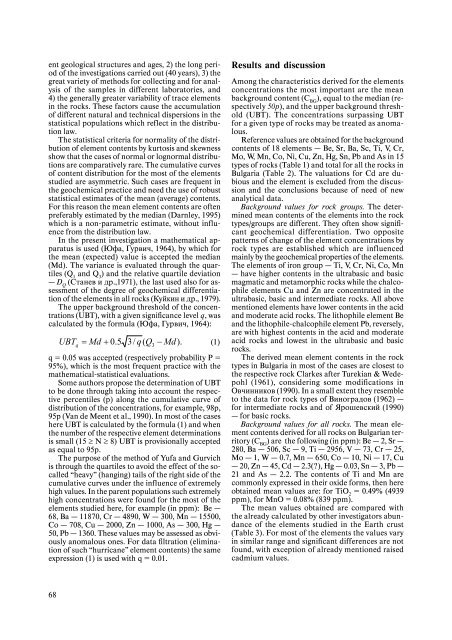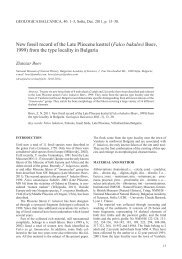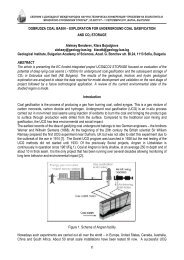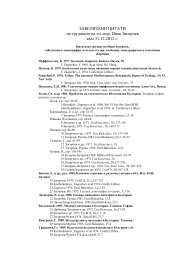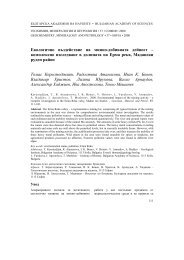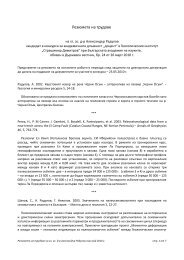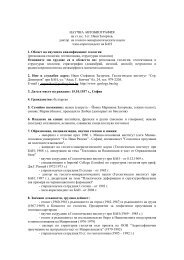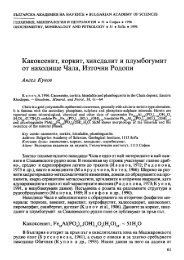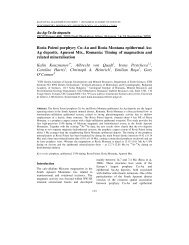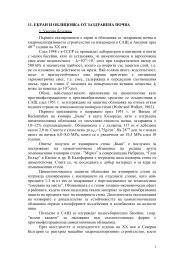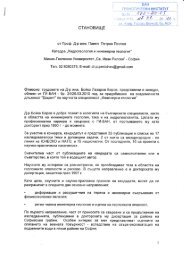Background contents of some minor and trace elements in the rocks ...
Background contents of some minor and trace elements in the rocks ...
Background contents of some minor and trace elements in the rocks ...
Create successful ePaper yourself
Turn your PDF publications into a flip-book with our unique Google optimized e-Paper software.
ent geological structures <strong>and</strong> ages, 2) <strong>the</strong> long period<strong>of</strong> <strong>the</strong> <strong>in</strong>vestigations carried out (40 years), 3) <strong>the</strong>great variety <strong>of</strong> methods for collect<strong>in</strong>g <strong>and</strong> for analysis<strong>of</strong> <strong>the</strong> samples <strong>in</strong> different laboratories, <strong>and</strong>4) <strong>the</strong> generally greater variability <strong>of</strong> <strong>trace</strong> <strong>elements</strong><strong>in</strong> <strong>the</strong> <strong>rocks</strong>. These factors cause <strong>the</strong> accumulation<strong>of</strong> different natural <strong>and</strong> technical dispersions <strong>in</strong> <strong>the</strong>statistical populations which reflect <strong>in</strong> <strong>the</strong> distributionlaw.The statistical criteria for normality <strong>of</strong> <strong>the</strong> distribution<strong>of</strong> element <strong>contents</strong> by kurtosis <strong>and</strong> skewnessshow that <strong>the</strong> cases <strong>of</strong> normal or lognormal distributionsare comparatively rare. The cumulative curves<strong>of</strong> content distribution for <strong>the</strong> most <strong>of</strong> <strong>the</strong> <strong>elements</strong>studied are asymmetric. Such cases are frequent <strong>in</strong><strong>the</strong> geochemical practice <strong>and</strong> need <strong>the</strong> use <strong>of</strong> robuststatistical estimates <strong>of</strong> <strong>the</strong> mean (average) <strong>contents</strong>.For this reason <strong>the</strong> mean element <strong>contents</strong> are <strong>of</strong>tenpreferably estimated by <strong>the</strong> median (Darnley, 1995)which is a non-parametric estimate, without <strong>in</strong>fluencefrom <strong>the</strong> distribution law.In <strong>the</strong> present <strong>in</strong>vestigation a ma<strong>the</strong>matical apparatusis used (Þôà, Ãóðâè÷, 1964), by which for<strong>the</strong> mean (expected) value is accepted <strong>the</strong> median(Md). The variance is evaluated through <strong>the</strong> quartiles(Q 1<strong>and</strong> Q 3) <strong>and</strong> <strong>the</strong> relative quartile deviation– D Q(Ñòàíåâ è äð.,1971), <strong>the</strong> last used also for assessment<strong>of</strong> <strong>the</strong> degree <strong>of</strong> geochemical differentiation<strong>of</strong> <strong>the</strong> <strong>elements</strong> <strong>in</strong> all <strong>rocks</strong> (Êóéêèí è äð., 1979).The upper background threshold <strong>of</strong> <strong>the</strong> concentrations(UBT), with a given significance level q, wascalculated by <strong>the</strong> formula (Þôà, Ãóðâè÷, 1964):UBT q= Md + 0.53/ q(Q3 − Md).(1)q = 0.05 was accepted (respectively probability P =95%), which is <strong>the</strong> most frequent practice with <strong>the</strong>ma<strong>the</strong>matical-statistical evaluations.Some authors propose <strong>the</strong> determ<strong>in</strong>ation <strong>of</strong> UBTto be done through tak<strong>in</strong>g <strong>in</strong>to account <strong>the</strong> respectivepercentiles (p) along <strong>the</strong> cumulative curve <strong>of</strong>distribution <strong>of</strong> <strong>the</strong> concentrations, for example, 98p,95p (Van de Meent et al., 1990). In most <strong>of</strong> <strong>the</strong> caseshere UBT is calculated by <strong>the</strong> formula (1) <strong>and</strong> when<strong>the</strong> number <strong>of</strong> <strong>the</strong> respective element determ<strong>in</strong>ationsis small (15 ≥ N ≥ 8) UBT is provisionally acceptedas equal to 95p.The purpose <strong>of</strong> <strong>the</strong> method <strong>of</strong> Yufa <strong>and</strong> Gurvichis through <strong>the</strong> quartiles to avoid <strong>the</strong> effect <strong>of</strong> <strong>the</strong> socalled“heavy” (hang<strong>in</strong>g) tails <strong>of</strong> <strong>the</strong> right side <strong>of</strong> <strong>the</strong>cumulative curves under <strong>the</strong> <strong>in</strong>fluence <strong>of</strong> extremelyhigh values. In <strong>the</strong> parent populations such extremelyhigh concentrations were found for <strong>the</strong> most <strong>of</strong> <strong>the</strong><strong>elements</strong> studied here, for example (<strong>in</strong> ppm): Be –68, Ba – 11870, Cr – 4890, W – 300, Mn – 15500,Co – 708, Cu – 2000, Zn – 1000, As – 300, Hg –50, Pb – 1360. These values may be assessed as obviouslyanomalous ones. For data filtration (elim<strong>in</strong>ation<strong>of</strong> such “hurricane” element <strong>contents</strong>) <strong>the</strong> sameexpression (1) is used with q = 0.01.Results <strong>and</strong> discussionAmong <strong>the</strong> characteristics derived for <strong>the</strong> <strong>elements</strong>concentrations <strong>the</strong> most important are <strong>the</strong> meanbackground content (C BG), equal to <strong>the</strong> median (respectively50p), <strong>and</strong> <strong>the</strong> upper background threshold(UBT). The concentrations surpass<strong>in</strong>g UBTfor a given type <strong>of</strong> <strong>rocks</strong> may be treated as anomalous.Reference values are obta<strong>in</strong>ed for <strong>the</strong> background<strong>contents</strong> <strong>of</strong> 18 <strong>elements</strong> – Be, Sr, Ba, Sc, Ti, V, Cr,Mo, W, Mn, Co, Ni, Cu, Zn, Hg, Sn, Pb <strong>and</strong> As <strong>in</strong> 15types <strong>of</strong> <strong>rocks</strong> (Table 1) <strong>and</strong> total for all <strong>the</strong> <strong>rocks</strong> <strong>in</strong>Bulgaria (Table 2). The valuations for Cd are dubious<strong>and</strong> <strong>the</strong> element is excluded from <strong>the</strong> discussion<strong>and</strong> <strong>the</strong> conclusions because <strong>of</strong> need <strong>of</strong> newanalytical data.<strong>Background</strong> values for rock groups. The determ<strong>in</strong>edmean <strong>contents</strong> <strong>of</strong> <strong>the</strong> <strong>elements</strong> <strong>in</strong>to <strong>the</strong> rocktypes/groups are different. They <strong>of</strong>ten show significantgeochemical differentiation. Two oppositepatterns <strong>of</strong> change <strong>of</strong> <strong>the</strong> element concentrations byrock types are established which are <strong>in</strong>fluencedma<strong>in</strong>ly by <strong>the</strong> geochemical properties <strong>of</strong> <strong>the</strong> <strong>elements</strong>.The <strong>elements</strong> <strong>of</strong> iron group – Ti, V, Cr, Ni, Co, Mn– have higher <strong>contents</strong> <strong>in</strong> <strong>the</strong> ultrabasic <strong>and</strong> basicmagmatic <strong>and</strong> metamorphic <strong>rocks</strong> while <strong>the</strong> chalcophile<strong>elements</strong> Cu <strong>and</strong> Zn are concentrated <strong>in</strong> <strong>the</strong>ultrabasic, basic <strong>and</strong> <strong>in</strong>termediate <strong>rocks</strong>. All abovementioned <strong>elements</strong> have lower <strong>contents</strong> <strong>in</strong> <strong>the</strong> acid<strong>and</strong> moderate acid <strong>rocks</strong>. The lithophile element Be<strong>and</strong> <strong>the</strong> lithophile-chalcophile element Pb, reversely,are with highest <strong>contents</strong> <strong>in</strong> <strong>the</strong> acid <strong>and</strong> moderateacid <strong>rocks</strong> <strong>and</strong> lowest <strong>in</strong> <strong>the</strong> ultrabasic <strong>and</strong> basic<strong>rocks</strong>.The derived mean element <strong>contents</strong> <strong>in</strong> <strong>the</strong> rocktypes <strong>in</strong> Bulgaria <strong>in</strong> most <strong>of</strong> <strong>the</strong> cases are closest to<strong>the</strong> respective rock Clarkes after Turekian & Wedepohl(1961), consider<strong>in</strong>g <strong>some</strong> modifications <strong>in</strong>Îâ÷èííèêîâ (1990). In a small extent <strong>the</strong>y resembleto <strong>the</strong> data for rock types <strong>of</strong> Âèíîãðàäîâ (1962) –for <strong>in</strong>termediate <strong>rocks</strong> <strong>and</strong> <strong>of</strong> ßðîøåâñêèé (1990)– for basic <strong>rocks</strong>.<strong>Background</strong> values for all <strong>rocks</strong>. The mean element<strong>contents</strong> derived for all <strong>rocks</strong> on Bulgarian territory(C BG) are <strong>the</strong> follow<strong>in</strong>g (<strong>in</strong> ppm): Be – 2, Sr –280, Ba – 506, Sc – 9, Ti – 2956, V – 73, Cr – 25,Mo – 1, W – 0.7, Mn – 650, Co – 10, Ni – 17, Cu– 20, Zn – 45, Cd – 2.3(?), Hg – 0.03, Sn – 3, Pb –21 <strong>and</strong> As – 2.2. The <strong>contents</strong> <strong>of</strong> Ti <strong>and</strong> Mn arecommonly expressed <strong>in</strong> <strong>the</strong>ir oxide forms, <strong>the</strong>n hereobta<strong>in</strong>ed mean values are: for TiO 2= 0.49% (4939ppm), for MnO = 0.08% (839 ppm).The mean values obta<strong>in</strong>ed are compared with<strong>the</strong> already calculated by o<strong>the</strong>r <strong>in</strong>vestigators abundance<strong>of</strong> <strong>the</strong> <strong>elements</strong> studied <strong>in</strong> <strong>the</strong> Earth crust(Table 3). For most <strong>of</strong> <strong>the</strong> <strong>elements</strong> <strong>the</strong> values vary<strong>in</strong> similar range <strong>and</strong> significant differences are notfound, with exception <strong>of</strong> already mentioned raisedcadmium values.68


